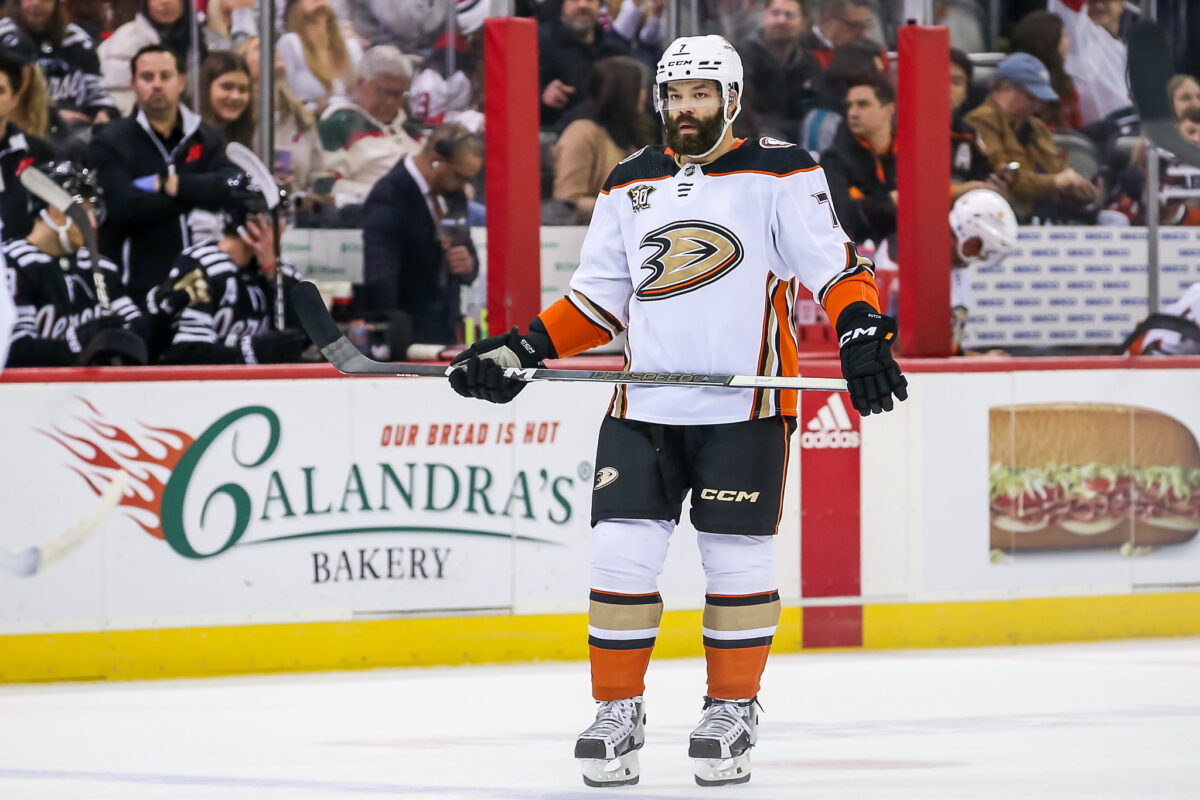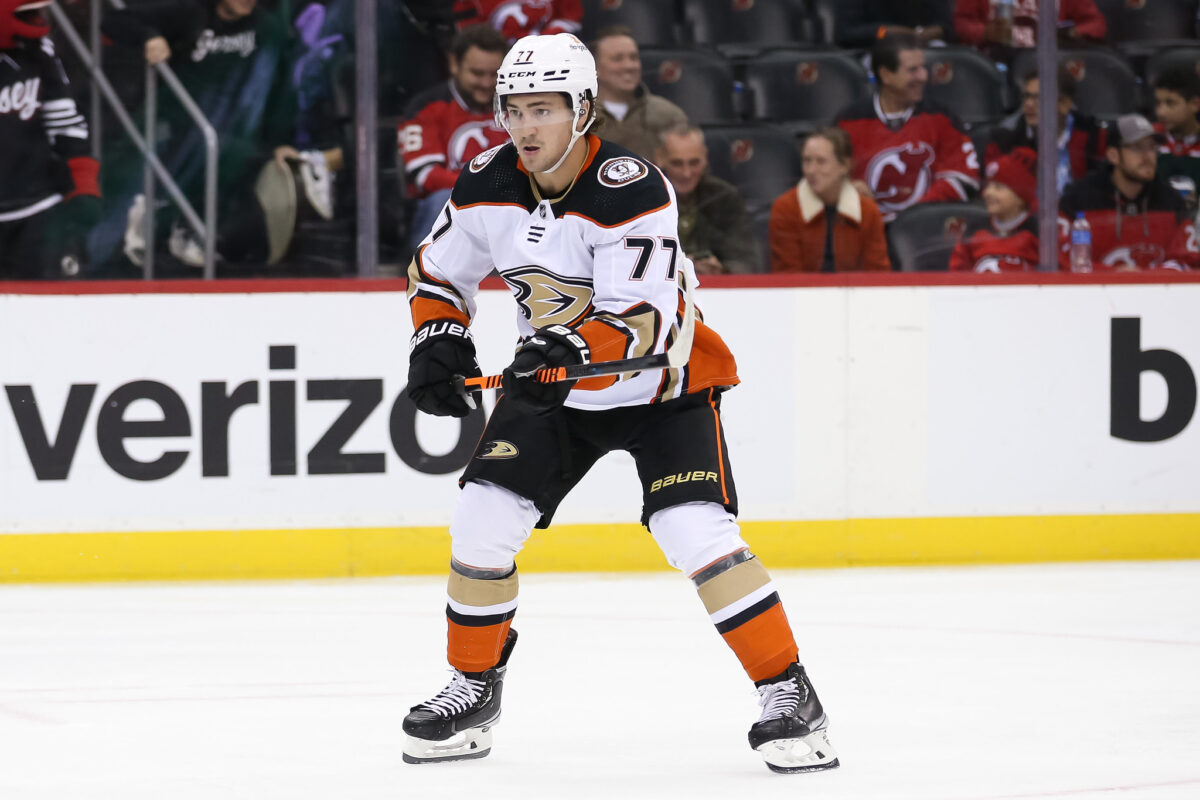The Anaheim Ducks hit the midseason mark with a 5-1 loss to the Tampa Bay Lightning on Jan. 13. The team sits 29th in the overall standings with a 15-28-1 record through 44 contests; they hold a one-point lead over the Ottawa Senators, who have five games in hand. The Ducks’ six-game winning streak from Oct. 24-Nov. 5 helped build a seven-point cushion on the last-placed San Jose Sharks and a three-point advantage over the Chicago Blackhawks.
The rebuilding Ducks were expected to be in the hunt for a lottery pick in the 2024 NHL Entry Draft rather than competing for a playoff spot this season, so the results have not been surprising. With 2023-24 more than halfway to its conclusion, it’s time to take stock of what the Ducks have accomplished, what needs to change, and what happens next before the organization switches to offseason mode.
Ducks’ Defense On The Rise
The Ducks’ revamped defense corps hasn’t been perfect by any means, but it has improved over last season. Opposing teams averaged a league-high 39.1 shots per game in 2022-23 versus the Ducks. The club has made some progress in that area, surrendering the fifth-most shots against per game (32.8). The Ducks also rank 10th in the league in hits (807) and ninth overall in blocked shots (727) after finishing 31st in hits and 19th in blocks last season. General manager Pat Verbeek wanted his team to be harder to play against, and the players have bought into that style for the most part.
Goaltending has been a bit of a roller coaster again, but taking away some of the pressure that John Gibson and Lukas Dostal face on a gamely basis has been noticeable. As a result, the Ducks rank 20th in the league in save percentage (.896), which is just slightly below the league average (.899). They also sit 17th overall in scoring chances against during 5-on-5 situations after allowing the most last season. The team is still allowing too many high-danger chances at 5-on-5 (tied for seventh-most in the NHL), but even that is an improvement over last campaign.
Radko Gudas has been a welcome addition, thanks in large part to his physicality. Pavel Mintyukov has made a big impact as a rookie, displaying his tremendous two-way upside. Despite being used sparingly, Tristan Luneau acquitted himself well during his first seven NHL outings. Jackson LaCombe has struggled in 2023-24 but could still carve out a role for himself in the top-six group. Cam Fowler has been leaned on heavily while delivering mixed results.

The Ducks also have talented defense prospects in their pipeline. At the American Hockey League (AHL) level, Olen Zellweger, Drew Helleson, and Tyson Hinds have been sharpening their skills with the San Diego Gulls. Zellweger, who will take part in the AHL All-Star Classic on Feb. 4-5, should get a look in the NHL before the end of the season. Additionally, Noah Warren, Rodwin Dionicio, Vojtech Port, and Konnor Smith have been developing in the junior ranks.
Ducks Still Struggling On Offense
Frank Vatrano, who will represent the Ducks at the NHL All-Star Game, has been a bright spot for the team offensively. He leads the club with 21 goals and 33 points in 44 appearances. The 29-year-old winger has bounced back in a big way after he produced just 22 goals and 41 points in 81 outings in 2022-23.
Mason McTavish has made great strides during his sophomore campaign, and Leo Carlsson has shown flashes of his immense potential as a future first-line center. It also appears as though the game management phase of Carlsson’s development plan has come to an end after he topped 20 minutes of ice time in back-to-back games Monday (Jan. 15) against the Florida Panthers and Tuesday (Jan. 16) versus the Washington Capitals.
Troy Terry, Adam Henrique, Ryan Strome, and Alex Killorn have also chipped in offensively, but the Ducks rank 29th in the league in goals per game (2.50) and have generated the fewest scoring chances in 5-on-5 situations this season. The team has been held to two goals or fewer in 24 of 29 losses. Terry and Killorn have been trying to work themselves back from sluggish starts. Trevor Zegras, who has been in and out of the lineup due to injuries, only has four goals and seven points in 20 contests. He got off to an unproductive start as well and has been mentioned as a possible trade candidate.
Related: Ducks News & Rumors: Gauthier, Zegras, Gibson, Luneau & More
Injuries to Zegras, McTavish, Carlsson, Mintyukov, and ex-Ducks defender Jamie Drysdale have played a role in the team’s offensive woes this campaign. The roster isn’t deep to begin with, so playing without key skaters and not getting the chance to ice a fully healthy lineup for most of the season has been an issue. Still, scoring goals isn’t a new problem for the Ducks. The team has potted the second-fewest goals in the league since 2020-21, with 668, which is just 43 more tallies than the Seattle Kraken in 56 more games.

Verbeek made what he hopes is a significant move to help resolve the team’s offensive deficiencies on Jan. 8 when he dealt Drysdale and a 2025 second-round pick to the Philadelphia Flyers in exchange for Cutter Gauthier. The 19-year-old Gauthier is a highly skilled top prospect who could make an immediate impact. He is expected to sign with the Ducks in the spring following the conclusion of his sophomore year with Boston College.
“He has obvious top-six talent,” Verbeek said after the deal. “He’s versatile. He can really shoot the puck and he’s got underrated playmaking skills. His skating ability is elite, in my opinion. I’ve been looking for more speed up front with our group and certainly fills that ticket…What I love about Cutter is he’s a shooter and goal scorer. He has a nice combination of playmaking ability as well, so I think not only will he be able to shoot the puck into the net, but I think he’s going to be able to make other players better too.”
Penalties Have Been A Problem For Ducks
The Ducks lead the league with 625 penalty minutes, including a whopping 208 minor infractions. They have 35 more minor penalties than the second-place Boston Bruins, Florida Panthers, and Detroit Red Wings. For all the good that Vatrano and Gudas have done this campaign, they rank first and second in the NHL, respectively, in minor penalties.
McTavish is fifth, Strome is tied for seventh, and Ilya Lyubushkin is tied for ninth. The Ducks’ net penalties (penalties drawn to penalties taken) of minus-44 is the worst in the league, and the team has been shorthanded an NHL-leading 186 times. Allowing the second-most power-play goals against (41) isn’t a recipe for sustained success. The Ducks will need to be much more disciplined in the second half.
Ducks Should Be Busy Ahead Of Trade Deadline
Verbeek is likely to move pending unrestricted free agents Jakob Silfverberg, Henrique, and Lyubushkin before the March 8 trade deadline. Contending teams seeking depth pieces could benefit from acquiring any of them, but Henrique is likely to yield the best return due to his versatility and scoring ability. The GM made a bold move by sending Drysdale out for Gauthier. That suggests that Zegras, Vatrano, Gibson, and Fowler could be trade candidates as well if the package coming back to the Ducks is substantial enough.
Ducks Need To Remain Competitive
The Ducks have lost some tight games, but the team has largely been much more competitive under new head coach Greg Cronin. They were battling back from deficits early in the season, but the lack of scoring has prevented those comebacks from happening lately.
They still need to be better on special teams, and Gauthier and Zellweger could eventually become permanent members of the top power-play combination. The penalty kill would benefit tremendously if the Ducks cut down on needless infractions with better positioning. Additionally, it would be helpful if the team managed to stay healthier. That’s always easier said than done, especially with the unpredictable nature of injuries, but having a healthy lineup would provide the Ducks’ brass with a much clearer idea of how to assess the roster moving forward.
Analytics courtesy of Natural Stat Trick.
